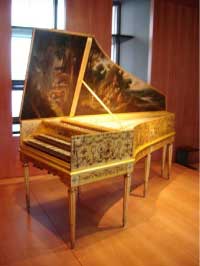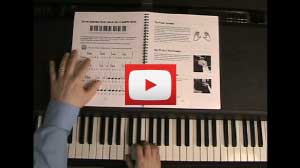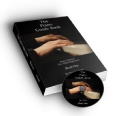Piano History
Piano Pre-History
Various stringed instruments were played in the centuries before piano history began. The lyre, the harp, lutes and similar instruments were in common usage. A particular instrument shares some important features, though. The hammer dulcimer stands out in piano history in that it had strings of varying lengths, stretched across a soundboard, attached with pins on one end, and hitched over a bridge. The strings were sounded by the player's striking the strings with mallets.
The Harpsichord

The first keyboard instruments were the massive church organs, which became somewhat widespread in the 15th and 16th centuries. The first keyboard string instruments were the harpsichord which became widely used at about the same time. The harpsichord's strings were plucked with quills, producing a soft, delicate sound. The player had no control over the loudness of the strings, or the duration of their sound. Many of the harpsichords and the later clavichord (which had limited dynamic control) had two keyboards. The key color configuration was the opposite of today's pianos: the sharps were white, the naturals were black.
Johann Sebastian Bach, Henry Purcell, Dominick Scarlatti and Wolfgang Amadeus Mozart and their contemporaries all composed for and performed on the harpsichord.
Bartelomeo Christofori

Bartelomeo Christofori, (1655-1731), was a well respected harpsichord builder in Padua, Italy, who worked for Prince Ferdinand de Medici. Christofori wanted to make a louder harpsichord that allowed the player to vary the volume level, and control the length of time that the note sounded. He presented his first "Gravcembalo col Piano e Forte" around 1709, which featured a new type of hammer action, which allowed gradations in volume, for the first time in piano history.
By 1720, Christofori had perfected his action, by including the escapement mechanism and hammer check. This innovation allowed the hammer to strike the string, but not remain in contact, which would mute the string. The hammer check let the hammer return to rest without bouncing back up (and striking the string again). This allowed the player to repeat the note quickly, and the hammers allowed the player to play more loudly.
Cristofori's innovations were not significantly improved in almost a century. His level of quality was unmatched for the same period of time. Only three of his original pianos are known to exist, one (in photo) is at the Metropolitan Museum of Art in New York City.
After Christofori
Christofori's "Piano-Forte" did not catch on quickly in Italy, but writer Scippine Maffei wrote an article about it that became widely distributed with harpsichord makers throughout Europe.
The German Builders
German keyboard builders were the first in piano history to take a significant interest in Christofori's invention, in the mid 18th century. Organ and harpsichord builder Gottfried Silbermann added the damper pedal to what was essentially a copy of Christofori's design. The damper pedal allowed all of the strings to mute or sustain together.
In the later 18th century, German harpsichord builder Johann Stein, who was living in Vienna, started making copies of Christofori's designs, then later added some of his own innovations. He got more volume out of the instrument by having two strings per note, and covering the hammers with leather. Mozart is known to have played Stein's instruments.
His daughter, Nannette Striecher, was also an innovator in piano design. She improved the escapement mechanism, and also made the piano louder. Beethoven played her instruments.
At the dawn of the industrial revolution, German ex-patriot Johann Zumpe, living in England took Christofori's design, and made it stronger and louder with steel casting. He also added an octave to the piano's range, making a 6 octave range.
The 19th Century
In the early 19th century, Pierre Sebastian Erard, a French harpsichord and piano builder developed the agraffe, which held the string's tension at the pin end. He also developed the double repetition mechanism in 1821, which is still in use today.
Englishman John Broadwood divided the bridge, creating a separate bass bridge. This enabled the bass hammers to hit the string at a more effective striking point, creating more power and tone. This made for the total departure from harpsichord design for the first time in piano history.
About 1800, an American named Hawkins made the first upright piano, with features anticipating later developments, including a cast iron frame. Unfortunately, his design did not find success because his pianos lacked tone.
In 1826, Bostonian Alpheus Babcock further developed the cast iron frame, later joining with Chickering to make the first one piece cast iron frame in piano history, for a square grand piano. In 1843, they would cast the first full grand iron frame.
In 1811, Warnum made the first successful upright, with the use of bridle tape and the center pin and flange design, both which have become standard elements.
Frenchman Henri Pape developed felt covered hammers and the use of three strings in the treble in 1826.
In 1855 Steinway introduces the first fully modern piano in New York City, most of which is the same as pianos made today.
There continues to be incremental refinements to the design of the piano, but most of what we know as the "piano" was developed between 1700 and 1850.
Here's a late 19th century Mason and Hamlin advertisement:

Start Playing Piano Today with the Piano Guide Quick Start Course!
Easy to follow step-by-step lessons designed for adult beginners. The next best thing to private lessons!
What You'll Learn:
- Notes on the piano/keyboard
- Proper fingering
- C major scale
- Chords
- How to read music
- And much more!

Video lessons - watch as I play everything for you.

